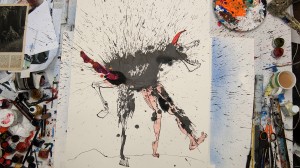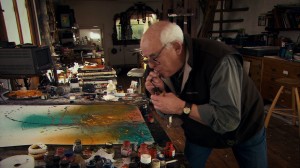
Reviews: Limited Runs
Wetlands (David Wnendt, Germany, 2013, 109 min)
Sundance Cinemas starting Friday, October 10»
Wetlands is not for the squeamish. A good test is the opening scene, where our 18-year old protagonist Helen (Carla Juri) walks barefoot in a flooded public restroom into a stall so that she can apply her hemorroid cream. After an amusing computer animated examination of just how disgusting the toilet is, Helen deliberately rubs herself all over the seat as an act of defiance against her uber-hygenic mother (Meret Becker). The film has been described as “gross-out” humor, but that is a little misleading for those expecting Judd Apatow. Gross-out, yes. Humor, definitely. But here Helen’s interest in pushing the boundaries of what society thinks about the body is rooted in a childhood of emotional abuse and psychological trauma. There’s a certain point watching Wetlands where you start to feel like you shouldn’t be laughing anymore, and that makes for a much more thought-provoking viewing experience (because you do keep laughing).
Despite some deficiencies in dramatic structure, Wetlands is always engaging due to the playful and brave performance by Juri as Helen. It quickly becomes clear that Juri is willing and able to do anything asked of her in this role. Helen is a charming flirt, a shameless exhibitionist, but also a wounded soul capable of inflicting the same kind of emotional abuse on her friends as she received from her parents during childhood. The film has many sequences of liberated whimsy as Helen defies conventions by skateboarding through hospital hallways or, um, switching bloody tampons with her best friend Corinna (Marlen Kruse). But Juri is equally brave in showing us how damaging Helen can be to the people around her, especially when Helen reacts to Corinna’s pregnancy with cold, manipulative words chosen with the precision of a laser.
After the first plot point, Helen spends most of the final two-thirds of the film in the hospital being treated for a self-inflicted anal fissure. The film becomes a bit too dependent on flashbacks and illustrated stories and it lacks genuine dramatic conflict. Those flashbacks and illustrated stories are often very funny (and, of course, gross), but structurally they often have the same effect as Family Guy tangents. Although Helen uses her hospital stay to plot a reunion of her parents, and she begins a (somewhat implausible) relationship with male nurse Robin (Christoph Letkowski), neither of these narrative threads sustain the same interest as the first third of the film. The emotional climax depends on the revelation of a specific trauma that Helen experienced involving her mother and younger brother. We know through flashbacks and pain-killer induced fantasies that the trauma is there, but we don’t know the details. But this suspense has more to do with the filmmakers choosing to conceal or reveal information to us, not a dramatic conflict for Helen. In other words, there is little drama because Helen does not have to re-discover this trauma, only we do. And the film also commits the sin of the most tired cliche that exists in films about young, troubled protagonists: it ends on a freeze frame of Helen yelling. (As we all know, is not permitted for any film after The 400 Blows.)
Despite the structural issues, overall Wetlands is a very engaging, crowd pleasing (mostly through eye rolls and groans) film. This is a break-out role for Juri, who hopefully will remain a presence in international cinema (and hopefully will be seen again on Madison screens). Wetlands is far more rewarding than many conventional “gross-out” comedies because the dark humor is so clearly rooted in emotional pain. In the best moments, you wince not only because it is gross, but also because you understand that the wild behavior is in part a consequence of psychological trauma.
For No Good Reason (Charlie Paul, UK/USA, 2012, 89 min)
Sundance Cinemas starting Friday, October 10»
As one of the weirdest openings in a Madison theater in recent memory, Charlie Paul’s documentary on English illustrator and artist Ralph Steadman, For No Good Reason, will play for a week at Sundance Cinemas starting today. Retroactively Sundance has declared this as a Screening Room Calendar selection, but the title does not appear on their online Calendar. You’ll only get one chance a day to see the film, at 4:25pm, so if you work 9 to 5, you’ll want to catch the film this weekend. Most people know Steadman for his collaborations with Hunter S. Thompson during the genesis of “gonzo journalism,” and certainly Thompson fans are a target audience for the film. But the film will also appeal to those who just want to see an interesting visual artist talk about his process and demonstrate with extended examples.
The promotional materials (naturally) emphasize Johnny Depp’s participation in the For No Good Reason, and indeed the film is framed as a visit by Depp to Steadman’s studio in their first meeting since a Hunter S. Thompson memorial (as you probably know, Depp plays Thompson in Fear and Loathing in Las Vegas and The Rum Diary). But you could cut out 99% of Depp’s appearance (except for his voice-overs as Thompson) and not change any of the informational content of the film. Luckily, Steadman himself is an engaging and articulate subject, and he guides us through his history as a comic illustrator, his collaborations with Hunter S. Thompson, and his more overtly political illustrations on his own.
While this is a well produced but not particularly distinguished documentary, it does serve as a good introduction to Steadman and his work. One problem is that one feels that the Thompson/Steadman story is now so well told that Steadman seems unwilling to say anything particularly new about the collaboration. In fact, the film gets a well needed burst of energy when Rolling Stone editor Jann Wenner suggests that Steadman was actually willing and able to push things further than Thompson was willing to. This introduces a much more engaging segment on Steadman’s work away from Thompson, and it is in these sequences that Steadman begins to talk with more energy about his goal of changing the world with his art.
 My favorite sequences, however, simply point the camera at Steadman as he works. Even in reproductions, Steadman’s paintings have a palpable physicality to them. While some of his work begins as photographs (some of which are pretty amazing on their own terms), other works begin with big plops of black India ink on a blank piece of paper. Like finding objects in clouds, Steadman discovers the painting during the process of its creation (influenced by Francis Bacon, whom we see in an archival interview). While Depp’s presence in these sequences is a little contrived, what does make them work is that you do get the sense of Steadman sharing observations and insights on his process with a friend.
My favorite sequences, however, simply point the camera at Steadman as he works. Even in reproductions, Steadman’s paintings have a palpable physicality to them. While some of his work begins as photographs (some of which are pretty amazing on their own terms), other works begin with big plops of black India ink on a blank piece of paper. Like finding objects in clouds, Steadman discovers the painting during the process of its creation (influenced by Francis Bacon, whom we see in an archival interview). While Depp’s presence in these sequences is a little contrived, what does make them work is that you do get the sense of Steadman sharing observations and insights on his process with a friend.
The final reason I find this theatrical run so strange is that For No Good Reason has been available on DVD and Blu-Ray for a little while now. This is common for campus and non-theatrical venues, and we wouldn’t fault them for the tight non-theatrical window. And certainly we welcome any chance to see anything on the big screen, regardless of its availability on home video. But we also hope that this does not begin a trend of even later theatrical openings for independent, international, and documentary films than what Madison already seems used to.
